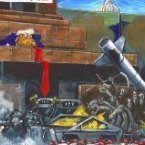Windows & Walls
-
Recently Browsing 0 members
- No registered users viewing this page.
-
Topics
-
-
Popular Contributors
-
-
Latest posts...
-
3
Burn the Flag
Thanks for the topic OP, good catch! He should of consulted with the Farleft extremists organizations that want to kill/US Burn/US down ! They/Them have tons of protesting legal experts . The statue: 36 CFR § 2.13 - Fires. The Park Police said it arrested one person in the park at about 6:30 p.m., citing a violation of 36 CFR 2.13(a)(1), which prohibits fire in public parks, except in designated areas. https://www.aol.com/man-arrested-flag-burning-incident-134614111.html https://www.law.cornell.edu/cfr/text/36/2.13 -
188
-
27
Ukraine is winning the war
What about genocide ukrainian nazis commit on over 100k polish and jewish people ? Did you already checked "zbrodnia wołyńska" on google pictures ? -
84
Americans seek escape for political reasons at record numbers
I've been in the US for 3 months. I am not going to go into all my observations, but here are some of the things I have noticed. I live in one of the only districts that voted for Trump in a state that didn't go for Trump. I haven't seen one MAGA hat or T-shirt with Trump's face on it since I have been back here this time. Gas prices have stabilized at 3.99 a gallon for regular, but the price of food continues to rise. Imported food has really jumped. The price for Thai coconut milk went from .99 to 1.29 in 2 weeks, and there is now coconut milk from VN at a bit lower price that I hadn't seen before. I checked around for a price for a tune-up for my 6-cylinder car, and the lowest I got was $500. I almost let on that I was shocked. The fast-food places that were looking for workers were offering $15.50 hr. I hope they don't need to drive to work! -
359
Road Rage (Foreigner Style)
Absolute nonsense. You're allowed to use the horn to prevent any accident. Not just to alert others of your approach. Even if you saw a car on the other lane about to cause an accident it would be perfectly legal to use the horn to warn them they're about to cause an accident The horn is not just for warning of your approach. Again total ignorance of the laws of traffic. -
84
Americans seek escape for political reasons at record numbers
A fascist is often defined as someone with whom I fundamentally disagree on political matters. Therefore, if your views oppose mine, you might be labeled a fascist. Furthermore, if you persist in asserting your perspective, it suggests a deeper issue that may reveal underlying racist or misogynistic attitudes. It’s essential to recognize the weight of our beliefs and the impact they have on the discourse we engage in.- 1
-

-
-
Popular in The Pub



.thumb.jpg.b54783ad387f65d779e04f535fcfeee9.jpg)









Recommended Posts
Create an account or sign in to comment
You need to be a member in order to leave a comment
Create an account
Sign up for a new account in our community. It's easy!
Register a new accountSign in
Already have an account? Sign in here.
Sign In Now